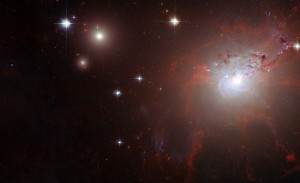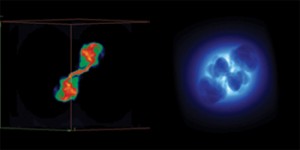
NASA/ESA/STSCL (L. FRATTARE)NGC 1275: giant galaxy at the center of the Perseus agglomerationNASA/ESA/STSCL (L. FRATTARE)
A fat old decadent galaxy that seems to have borrowed gas from its neighbors to get back to making stars is helping a group of astronomers decipher the mysteries of agglomerations in the galaxy, the building blocks of the largest structures in the Universe. Shaped like a flattened sphere, the galaxy lies toward the constellation of Perseus, the mythological Greek hero that decapitated the Medusa, and it is huge: it has 10 to 100 times more matter than the Milky Way, our galaxy, which is comprised of some 200 billion stars, and it keeps others gravitationally captive around it. Known as the Perseus agglomeration, this group of galaxies has a striking characteristic that has puzzled, for a long time, those who study it: it is permeated by a huge cloud of very rarified hot gas, with some regions being far hotter than one would expect.
The laws of physics dictate that as the gas of the neighboring galaxies is drawn by gravity toward the central galaxy, in this case, NGC1275, which lies at 235 million light-years from the Earth, the gas density should increase whereas its temperature should drop markedly. “As the gas becomes denser near the center of the agglomeration, the particles that form it collide more easily with each other and lose energy in the form of radiation,” explains the astrophysicist Elisabete de Gouveia Dal Pino, who has been studying the Perseus agglomeration for the last few years. Thus, the greater the density and proximity relative to the central galaxy, the colder the gas should be. However, this is not quite what seems to be happening with Perseus.
It is true that the temperature of the gas in the agglomerate does actually drop, but neither as much nor in the way that it should. Measurements taken with telescopes on Earth and in space showed that the temperature falls from almost 10 million degrees in the regions that lie furthest away from NGC 1275 to 3 million degrees around half way and that it then stabilizes, whereas one would expect it to fall by some hundreds of thousands of degrees. This effect can only be explained by something reheating the gas in the agglomeration’s more central region, thereby offsetting the heat loss.
For quite some time, researchers have had a candidate for this: a huge black hole whose mass equals that of hundreds of millions of stars like the Sun, situated right in the middle of NGC 1275. Black holes are such dense and compact objects that nothing can escape their surface, not even light. However, a lot of energy is released in their vicinity. Before it is drawn in and absorbed, the matter that spirals around a black hole gains acceleration due to gravity. Part of it, with the aid of magnetic fields, escapes in two narrow rays that leave the poles of the black hole, giving rise to particle jets that move at a speed close to that of light. These jets release radio waves that astronomers can detect.
Images produced by X-rays, another type of radiation, showed that the vicinity of the NGC 1275 black hole (the region in space also known as active galactic nucleus because it releases more energy that the rest of the galaxy) released enough energy to keep the gas hot in the more central portion of the agglomeration. However, there was still a mystery: how could the gas temperatures be more or less homogeneous if the black hole radiation jets were so narrow?
By conducting computer simulations, the group coordinated by Elisabete Dal Pino and Zulema Abraham, researchers from the Institute of Astronomy, Geophysics and Atmospheric Sciences at the University of São Paulo (IAG-USP), in the São Paulo state capital, found a possible answer. “The temperatures could be those observed if the active galactic nucleus were in precession [change in the inclination of the rotation axis],” states Elisabete. The idea can be translated as follows: to keep the temperature roughly homogenous, it is necessary for the inclination of the rotation axis of the central object to vary and for the jets to fluctuate, thereby distributing energy better. Or, more simply put, this can happen if the black hole wobbles like a top that is losing speed.
The simulations conducted by Diego Falceta-Gonçalves, from Cruzeiro do Sul University (Unicsul) in São Paulo, yielded similar results to those observed in nature when the angle of oscillation of the axis was great: 60 degrees. In the Astrophysical Journal Letters article in which the researchers presented their results in early 2010, the issue was explained: as the jets oscillate over time, the released energy is about equal in all directions. It is as if the radiation rays worked like the beaters in a mixer, mixing the cake’s ingredients to turn it into a homogeneous mass. However, this may not be the only explanation.

DIEGO GONÇALVES/UNICSUL AND NASA/CXCOHeat source: particle jets, on the left, heat the gas between the galaxies, at the sideDIEGO GONÇALVES/UNICSUL AND NASA/CXCO
In mid-2008, Elisabete Dal Pino was visiting the University of Wisconsin in Madison, in the United States, when the American astronomer John Gallagher showed her a result that he had just obtained and had not yet even published. Gallagher and his group had taken measurements of the gas filaments around the NGC 1275. “He was intrigued because they obtained maps of the speeds of the filaments and they realized that some of them were pulling away from the galaxy rather than moving toward it, which is what one would expect,” the astrophysicist tells us.
The result, published the following year in Nature, was an unexpected measurement. It indicated that some type of force was offsetting gravity, pushing the gas outward from NGC 1275. Moreover, magnetic forces were causing the filaments to arch. It was unlikely that the active galactic nucleus, no matter how powerful it might be, was producing this phenomenon on its own. So what might be happening?
“That was when I had the idea of supernovas,” says the Brazilian researcher. Supernova is the name of a very high mass star that has consumed all its fuel and has exploded. It is one of the Universe’s most energetic events. A series of supernovas might explain the shape of the filaments around the central galaxy of the agglomeration. The only problem is that recent supernovas imply recent stellar formations and a galaxy such as the NGC 1275 no longer has the raw material to make high mass stars.
In another series of simulations, this time partnered by John Gallagher and Alex Lazarian, both of them from Wisconsin, Falceta-Gonçalves and Elisabete showed that the falling gas from neighboring galaxies might produce a shock wave on NGC 1275’s surface and generate a sudden star formation episode. Stars with a lot of mass burn their fuel faster than smaller bodies such as the Sun, which take billions of years to be exhausted. Therefore, there might be a wave of supernova explosions just a few million years after the star formation process.
With the aid of computers, the researchers simulated what would happen 120 million years after the birth of the stars. The work, also published in Astrophysical Journal Letters, indicated that the interaction of the radiation released by the active galactic nucleus with the turbulences generated by the supernovas produces a pattern of filaments very similar to the one observed around NGC 1275. “Each simulation, at the maximum resolution of 100 million pixels, takes about 20 days to be completed,” says Falceta-Gonçalves, who conducted most of the tests and is the first author of the articles.
These studies undoubtedly provide plausible explanations for the mysteries surrounding NGC 1275. However, how is one to find out the real cause of the homogeneous distribution of the temperature of the gas and of the filaments observed around the galaxy? One of the means of proving these explanations would be to look, with telescopes, for signs left by stars of very high mass and by supernovas in the more external regions of NGC 1275. Another strategy, more within the reach of the Brazilian team, would be to conduct new simulations, now combining the precession effect of the active galactic nucleus with the explosion of supernovas on the edges of the galaxy, to find out what happens.
In any event, a little more progress has been made toward understanding the dynamics of galaxy agglomerations such as Perseus and, therefore, of the agglomeration to which the Milky Way belongs. These building blocks of the Universe, which on a larger scale are organized into super-agglomerations, still hold many secrets. Luckily, however, astronomers do not give up easily.
The projects
1. Investigation of high energy and plasma astrophysics phenomena: theory, observation and numerical simulations (nº 2006/50654-3); Type Thematic Project; Coordinator Elisabete de Gouveia Dal Pino – IAG-USP; Investment R$ 342,429.60
2. Numerical study of collisional and non-collisional magnetized plasmas in astrophysics (nº 2009/10102-0); Type Regular Research Awards; Coordinator Diego Falceta-Gonçalves – Unicsul; Investment R$ 110,400.00
Scientific articles
FALCETA-GONÇALVES, D. et al. Turbulence and the formation of filaments, loops and shock fronts in NGC 1275. The Astrophysical Journal Letters. v. 708 (1), p. L57-L60. 1 Jan. 2010.
FALCETA-GONÇALVES, D. et al. Precessing jets and X-ray bubbles from NGC 1275 (3C84) in the Perseus galaxy cluster: a view from 3D numerical simulations. The Astrophysical Journal Letters. v. 713 (1), p. L74-L78. 10 Apr. 2010.